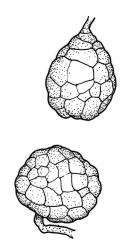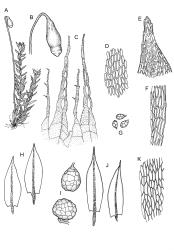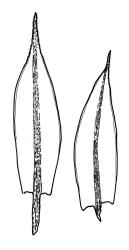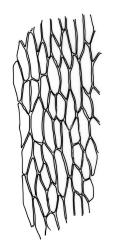- ≡ Gemmabryum tenuisetum (Limpr.) J.R.Spence & H.P.Ramsay, Phytologia 87: 68 (2005)
Stems to c. 6 mm, beset below with pale brown rhizoids. Leaves evenly spaced on stem, erect-spreading moist, becoming more erect and narrowed when dry, ovate- or elliptic-lanceolate, acute, denticulate above, very weakly bordered, ± recurved at margins, not decurrent, c. 1.2–1.5 × 0.3–0.4 mm, with lamina forming c. 0.85–0.9 of entire length; mid laminal cells thin-walled, c. 45–54 × 10 µm; marginal cells elongate in 1–2 rows, forming a very weak border. Costa stout and excurrent. Tubers numerous, yellow-brown, ± spherical, 210–250(–300) µm, c. 6–8 cells across, with cells ± protruding.
Dioicous. Perichaetial leaves linear-lanceolate, c. 2.5 mm. Perigonia terminal. Sporophytes not seen.
Crundwell & Nyholm 1964, fig. 6 a–m; Smith 2004, fig. 190, 9–13.
NI: N Auckland (sterile material only from Waimauku).
Adventive and known only from an artificial habitat. Reported from mainland Australia, Eurasia, and North America by Spence & Ramsay (2006). The northern hemisphere distribution outlined by Smith (2004) is very wide.
The single collection recorded here was collected by Noel Turner from an artificial habitat: well-drained, sterilised potting soil between pepino (Solanum muricatum) bushes, growing under shade.
Bryum tenuisetum is one of six N.Z. members of the "B. erythrocarpum complex" sensu Crundwell & Nyholm (1964). The complex is discussed in more detail under B. duriusculum.
Bryum tenuisetum is known from only a single N.Z. collection and is reservedly accepted here. The N.Z. material is anomalous in having thinner-walled laminal cells than European material. The thin-walled laminal cells set it apart from all N.Z. members of the B. erythrocarpum complex except B. rubens. The laminal cells in B. tenuisetum are much narrower and its tuber colour different from those in B. rubens.
Collections recorded by Bartlett (1984) from Kawarau Gorge, central Otago have not been examined. There is only one poorly documented J.K. Bartlett collection from central Otago in AK (Jessica Beever and Dhahara Ranatunga, pers. comm., Jan. 2015); Jessica Beever informed me that it (AK 186449) differs in many significant features from the Waimauku collection and it is not considered further.







